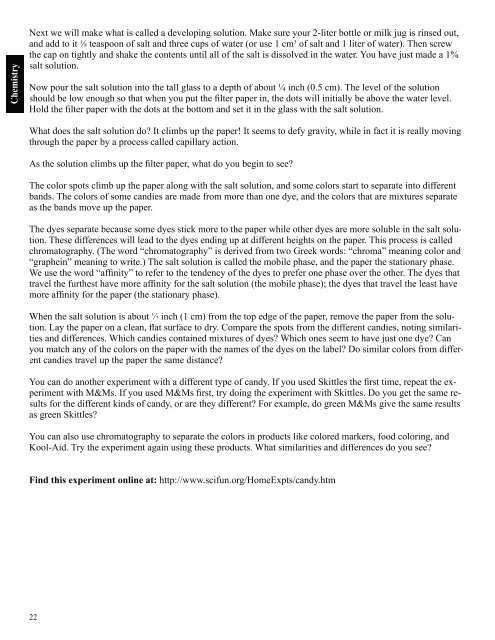ScienceMakers Toolkit Manual - The History Makers
ScienceMakers Toolkit Manual - The History Makers
ScienceMakers Toolkit Manual - The History Makers
You also want an ePaper? Increase the reach of your titles
YUMPU automatically turns print PDFs into web optimized ePapers that Google loves.
Chemistry<br />
Next we will make what is called a developing solution. Make sure your 2-liter bottle or milk jug is rinsed out,<br />
and add to it 1 ⁄ 1 3 ⁄ ⁄8 ⁄ 8 teaspoon of salt and three cups of water (or use 1 cm of salt and 1 liter of water). <strong>The</strong>n screw<br />
the cap on tightly and shake the contents until all of the salt is dissolved in the water. You have just made a 1%<br />
salt solution.<br />
Now pour the salt solution into the tall glass to a depth of about ¼ inch (0.5 cm). <strong>The</strong> level of the solution<br />
should be low enough so that when you put the fi lter paper in, the dots will initially be above the water level.<br />
Hold the fi lter paper with the dots at the bottom and set it in the glass with the salt solution.<br />
What does the salt solution do? It climbs up the paper! It seems to defy gravity, while in fact it is really moving<br />
through the paper by a process called capillary action.<br />
As the solution climbs up the fi lter paper, what do you begin to see?<br />
<strong>The</strong> color spots climb up the paper along with the salt solution, and some colors start to separate into different<br />
bands. <strong>The</strong> colors of some candies are made from more than one dye, and the colors that are mixtures separate<br />
as the bands move up the paper.<br />
<strong>The</strong> dyes separate because some dyes stick more to the paper while other dyes are more soluble in the salt solution.<br />
<strong>The</strong>se differences will lead to the dyes ending up at different heights on the paper. This process is called<br />
chromatography. (<strong>The</strong> word “chromatography” is derived from two Greek words: “chroma” meaning color and<br />
“graphein” meaning to write.) <strong>The</strong> salt solution is called the mobile phase, and the paper the stationary phase.<br />
We use the word “affinity” to refer to the tendency of the dyes to prefer one phase over the other. <strong>The</strong> dyes that<br />
travel the furthest have more affinity for the salt solution (the mobile phase); the dyes that travel the least have<br />
more affinity for the paper (the stationary phase).<br />
When the salt solution is about 1 ⁄ 1 1⁄ ⁄2 ⁄ 2 inch (1 cm) from the top edge of the paper, remove the paper from the solution.<br />
Lay the paper on a clean, fl at surface to dry. Compare the spots from the different candies, noting similarities<br />
and differences. Which candies contained mixtures of dyes? Which ones seem to have just one dye? Can<br />
you match any of the colors on the paper with the names of the dyes on the label? Do similar colors from different<br />
candies travel up the paper the same distance?<br />
You can do another experiment with a different type of candy. If you used Skittles the fi rst time, repeat the experiment<br />
with M&Ms. If you used M&Ms fi rst, try doing the experiment with Skittles. Do you get the same results<br />
for the different kinds of candy, or are they different? For example, do green M&Ms give the same results<br />
as green Skittles?<br />
You can also use chromatography to separate the colors in products like colored markers, food coloring, and<br />
Kool-Aid. Try the experiment again using these products. What similarities and differences do you see?<br />
Find this experiment online at: http://www.scifun.org/HomeExpts/candy.htm<br />
22










